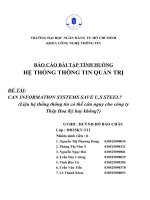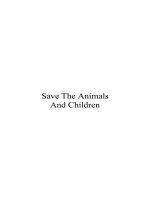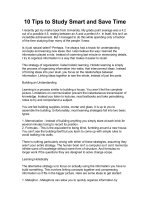SAVE FOOD think eat save o connor
Bạn đang xem bản rút gọn của tài liệu. Xem và tải ngay bản đầy đủ của tài liệu tại đây (583.74 KB, 18 trang )
Think.Eat.Save:
Global Food Waste Prevention
Düsseldorf
May 8th, 2014
Clementine O’Connor
UNEP Sustainable Food Systems Consultant
The Food Security Challenge
•
About 870 million people – just over 15 percent of the world’s population – are undernourished today.
•
In 2009, the world produced 2831 cal/person per day, which is enough to feed the planet.
•
At the same time, at least one third or 1.3 billion tonnes of food is waste every year
•
By 2050, the world’s population will reach 9 billion people – eliminating food waste is a critical to global food security
strategy
World of Waste
World of Waste
• Between 2007 and 2008, China wasted an estimated 50 million tonnes of food protein, which is enough to feed 200
million people.
• South Korea estimated that in 2012, the 50 million Koreans generate up to 170,000 tonnes of food waste daily, or about
350 grams (over 12 ounces) per person per day.
The annual loss of economic value exceeds $1.5 billion.
•
In the US, around 40 % of all food goes to waste each year. The cost is estimated at $195 billion per year (including $40
billion for households).[source: NDRC]
Food waste is water, energy, pesticides…
• In the UK, £1 billion-worth of the food wasted annually is food still « in date » and so perfectly edible ($1,5 bn).
=> If this quantity of food was not wasted, the saving in energy consumed in its production, packaging and transport would be the
equivalent of taking
20% of cars off the road in the country.
• Water needed to grow:
1kg of apples: 822 litres
250 ml milk: 255 litres
1kg of chicken meat: 4,325 litres
1kg of beef: 15,415 litres
Nb: These figures are average: water consumption depends on climate, variety, agricultural practices, length of growing season and degree of onward processing.
Food waste is money
• French people throw away 20 kilos of food every year, representing between 500 to 1500 euros per year ($600-$1900). 1/3 is
composed of food products that are not even opened or consumed. [source: France Nature Environnement]
• In the UK, average cost of food waste per household is £480 a year ($700), which accumulates to £15,000-24,000 over a lifetime
($22,500 -$36,000).
• For the average U.S. household of four, food waste translates into an estimated $1,350 to $2,275 in annual losses [Source: quoted in
NDRC issue Paper (August 2012). Bloom, American Wasteland, 187]
• Nb: methodologies used to evaluate economic cost are different according to countries and sources, which means that figures cannot be compared directly.
The Vision: Zero Hunger Challenge
• Element 5: Zero lost or wasted food
• UNEP co-leads responsibility for this challenge
• Implementation via the Think.Eat.Save initiative
The Approach
Delivering tools: Guidance for reducing food waste in businesses and households
• Guidance for public authorities, businesses and other organisations on mapping, planning
and delivering effective food waste prevention strategy
• To be published in late May
• To be piloted in selected countries/cities worldwide – contact us for further information
about piloting
Come and pick up your copy of the Executive Summary at the Think.Eat.Save stand!
Communication: The Think.Eat.Save. Campaign
• Multi-lingual campaign of the SAVE FOOD Initiative
• Launched in January 2013
• A partnership between UNEP, FAO and Messe Düsseldorf, and in support of the UN Secretary-General’s Zero
Hunger Challenge
•Seeks to:
galvanize widespread global, regional and national actions
catalyze more sectors of society to be aware and to act
connect food waste prevention to food security, ecosystems impact, climate change and sustainable
consumption and production
The Campaign: Think.Eat.Save.
Objectives:
•
•
•
Raise awareness on food waste prevention
Inspire action
Share best practice
The website www.thinkeatsave.org:
•
•
•
One stop shop for news and resources
Showcases ideas and examples
Launches call for public action
The Campaign: First Year Results
•
•
•
Over 160,000 visitors to the English website alone
Monthly average Twitter reach of 5 million
92 articles were published, 30 blogs and colossal amount of Food Waste related information also published in
terms of videos, tips, facts and figures as well as infographics
•
An estimated 26,589 articles and references to Think.Eat.Save and WED were published online between 1
and 10 June 2013 in UN languages.
The Campaign: World Environment Day 2013
•
•
•
Food waste key theme of World Environment Day, June 5
th
2013
WED website reached 1 million visits in month of June alone
WED was amongst the top 10 most talked about topics in Argentina, Australia, Brazil, Chile, Columbia,
Guatemala, India, Italy, Malaysia, Mexico, Pakistan, Philippines, Spain, South Africa and Venezuela on June 5
•
•
In India #ThinkEatSave was the number 1 topic of social media conversations for the duration of June 5
th
th
Policy influencers adopting WED messaging included Najib Razak (Malaysian PM), Nelson Mandela (Notable UN
voices included Christiana Figueres, Valerie Amos, and Helen Clark)
The Campaign: Other notable events
•
700 high level delegates dined on Food Grown in Kenya But Rejected by UK Supermarkets for Cosmetic
Reasons (February 2013 in Nairobi)
•
The Annakshetra Foundation fed 9200 People on Leftover Food from Wedding Parties in Jaipur (India, May
13)
•
•
Feeding the 5000 - OzHarvest – Think.Eat.Save events across Austrialia (Jul 13)
Tesco Poland launched a competition to Help Schools Think.Eat.Save! (Oct 2013)
The Campaign: Other notable events
•
Think.Eat.Save Goodwill Ambassador Giselle
Bündchen shares key campaign messages on
cooking segment of NBC Today Show, reaching
estimated 4.6 million viewers
The Campaign: First Year Findings
•
Goodwill Ambassadors were a huge boost to the campaign, through their own social media channels, event
organization and engaging with the public via unep.org Expert of the Day
•
Food waste experts around the world supported the campaign by engaging the public through various
forums, online platforms, articles for the website and UNEP’s Our Planet magazine
•
Social media was a strong driver for the campaign, partners and supporters helping to proliferate campaign
messages
This is only the beginning…
Please join us to Think Eat Save!
www.thinkeatsave.org
Clementine O’Connor
@cxoconnor
#ThinkEatSave
This is only the beginning…
Please join us to Think Eat Save!
www.thinkeatsave.org
Clementine O’Connor
@cxoconnor
#ThinkEatSave









